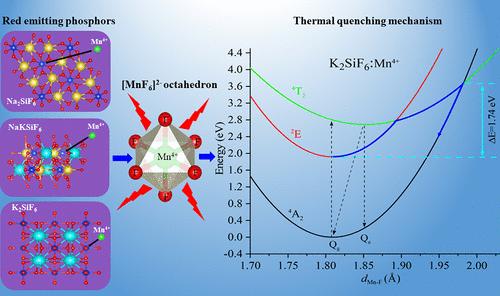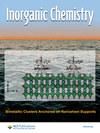Thermal Quenching Mechanism of Mn4+ in Na2SiF6, NaKSiF6, and K2SiF6 Phosphors: Insights from the First-Principles Analysis
IF 4.3
2区 化学
Q1 CHEMISTRY, INORGANIC & NUCLEAR
引用次数: 0
Abstract
This study aims to identify the key factors governing the thermal quenching of Mn4+ ion luminescence in fluoride-based phosphor materials used as red emitters in modern-day phosphor-converted LED devices. Here, we employ first-principles calculations for Mn4+-doped Na2SiF6, NaKSiF6, and K2SiF6 hosts to explore how host properties and local coordination environments influence thermal quenching behavior. The ΔSCF method was used to model the geometric structures of the Mn4+4A2 (ground) and 2E, 4T2 (excited) states and the energies of the optical transitions between these states. Our results reveal that thermal quenching in Na2SiF6 and K2SiF6 phosphors occurs through thermally activated 2E → 4T2 → 4A2 crossover. In contrast, thermal quenching in NaKSiF6 is due to other nonradiative decay pathways. Investigations of the mechanical stability of these fluorides show that NaKSiF6 is mechanically unstable. We suggest that this property of the host limits the luminescence efficiency of the embedded Mn4+ ions. We also determined the reason for the difference in the intensity of the 2E → 4A2 emission transition (ZPL) in the systems. These findings advance our fundamental understanding of the thermal quenching mechanism of Mn4+ ion luminescence in fluorides, and the results can aid future discoveries of technologically useful phosphors through high-throughput design methodologies.

Na2SiF6、NaKSiF6 和 K2SiF6 荧光中 Mn4+ 的热淬机制:第一原理分析的启示
本研究旨在找出影响氟化物荧光粉材料中 Mn4+ 离子发光热淬灭的关键因素,这些材料被用作现代荧光粉转换 LED 器件中的红色发光体。在此,我们采用第一原理计算掺杂了 Mn4+ 的 Na2SiF6、NaKSiF6 和 K2SiF6 宿主,探索宿主特性和局部配位环境如何影响热淬灭行为。我们采用 ΔSCF 方法来模拟 Mn4+4A2 (基态)和 2E、4T2 (激发态)的几何结构以及这些态之间的光学跃迁能量。我们的研究结果表明,Na2SiF6 和 K2SiF6 荧光中的热淬灭是通过热激活的 2E → 4T2 → 4A2 交叉发生的。与此相反,NaKSiF6 的热淬火是由其他非辐射衰变途径引起的。对这些氟化物机械稳定性的研究表明,NaKSiF6 的机械稳定性并不稳定。我们认为宿主的这一特性限制了嵌入的 Mn4+ 离子的发光效率。我们还确定了系统中 2E → 4A2 发射转变(ZPL)强度不同的原因。这些发现推进了我们对氟化物中 Mn4+ 离子发光的热淬灭机制的基本理解,其结果有助于未来通过高通量设计方法发现技术上有用的荧光粉。
本文章由计算机程序翻译,如有差异,请以英文原文为准。
求助全文
约1分钟内获得全文
求助全文
来源期刊

Inorganic Chemistry
化学-无机化学与核化学
CiteScore
7.60
自引率
13.00%
发文量
1960
审稿时长
1.9 months
期刊介绍:
Inorganic Chemistry publishes fundamental studies in all phases of inorganic chemistry. Coverage includes experimental and theoretical reports on quantitative studies of structure and thermodynamics, kinetics, mechanisms of inorganic reactions, bioinorganic chemistry, and relevant aspects of organometallic chemistry, solid-state phenomena, and chemical bonding theory. Emphasis is placed on the synthesis, structure, thermodynamics, reactivity, spectroscopy, and bonding properties of significant new and known compounds.
 求助内容:
求助内容: 应助结果提醒方式:
应助结果提醒方式:


